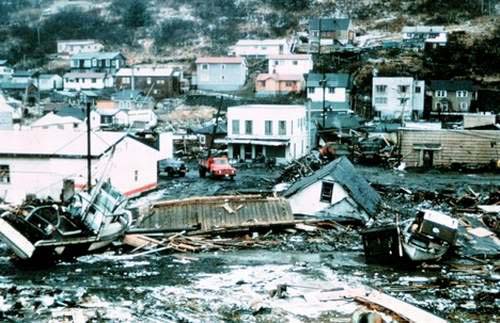9.2 Earthquake in Alaska

1964 Alaska earthquake Wikipedia
The 1964 Alaskan earthquake, also known as the Great Alaskan Earthquake and Good Friday Earthquake, was a megathrust earthquake that began at 5:36 P.M. AST on Good Friday, March 27, 1964. Across south-central Alaska, ground fissures, collapsing structures, and tsunamis resulting from the earthquake caused about 139 deaths. Lasting nearly three minutes, it was the most powerful recorded earthquake in U.S. and North American history, and the second most powerful ever measured by seismograph.It had a moment magnitude of 9.2, making it the second largest earthquake in recorded history - the largest being the 1960 Valdivia earthquake in Chile.
11 Facts About the 1964 Alaska Earthquake Live Science - March 27, 2014
1. Of the 131 people killed during the earthquake, 119 died in tsunamis. Most were killed by tsunamis triggered by underwater landslides, not by the earthquake-induced tsunami.
2. In Chenega, 25 of the village's 76 residents drowned in a tsunami. The only building that survived the wave intact was the schoolhouse, built 100 feet (30 meters) above sea level.
3. Several towns and villages were moved to safer ground after the tsunamis, including Seward, Valdez, Girdwood and Chenega.
4. The tallest tsunami wave height was 219 feet (67 m) in Shoup Bay in the Valdez Inlet. <> 5. The world rang like a bell for several weeks from the earthquake waves.
6. Seiche waves, sloshing of water back and forth in a small body of water like a boat harbor or swimming pool, were noted as far away as Louisiana, where a number of fishing boats were sunk. Oscillations in the height of water in wells were reported as far away as South Africa.
7. The earthquake initially had a magnitude of 8.5 on the Richter scale. The moment magnitude scale, a better measure of seismic power, has since superseded the Richter scale. The new size estimate is magnitude 9.2, the second most powerful ever recorded.
8. If the energy of a magnitude-5 earthquake is like snapping a single spaghetti strand, then a magnitude-9.2 earthquake releases enough energy to snap 800,000 spaghetti strands, according to the U.S. Geological Survey.
9. The damage totaled about $300 million in 1964 dollars ($2.3 billion in 2013 dollars).
10. Four out of five earthquakes in the United States occur in Alaska.
11. After the 1964 megathrust earthquake, three-quarters of the Aleutian subduction zone ruptured in a span of eight years. The subduction zone is 2,100 miles (3,300 kilometers) long.
How the 1964 Alaska Earthquake Shook Up Science Live Science - March 27, 2014
There were great horrors, but what many children remember is missing their supper. The earthquake struck at 5:36 p.m. Alaska Standard Time on Good Friday. When the first shaking hit, many parents were in the kitchen, fixing dinner. For more than 4 minutes, the earth buckled and lurched all across southern Alaska. Few people returned home to their meals that night. In Anchorage, the ground cracked open and giant fissures swallowed children whole, killing them in front of their siblings. Landslides launched tsunamis that swept away coastal villages before the shaking even ended. In Seward, spilled oil slicked the water and caught fire. When the earthquake-triggered tsunami hit minutes later, the wave was blazing. "It was an eerie thing to see - a huge tide of fire washing ashore," survivor Gene Kirkpatrick told National Geographic magazine in 1964. In 50 years, no earthquake since has matched the power of the March 27, 1964, Great Alaska earthquake. Now ranked a magnitude 9.2, the second-largest ever recorded, the earthquake radically transformed the young state. Important coastal ports, roads and rail lines were destroyed. The liquefied ground in Anchorage led to the country's strictest seismic building codes (now outpaced by California). President Lyndon Johnson ordered a comprehensive scientific study of the earthquake.